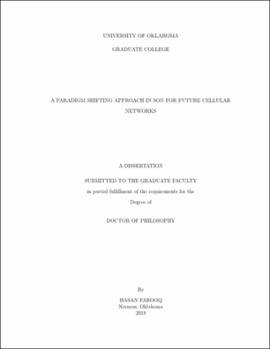| dc.description.abstract | The race to next generation cellular networks is on with a general consensus in academia and industry that massive densification orchestrated by self-organizing networks (SONs) is the cost-effective solution to the impending mobile capacity crunch. While the research on SON commenced a decade ago and is still ongoing, the current form (i.e., the reactive mode of operation, conflict-prone design, limited degree of freedom and lack of intelligence) hinders the current SON paradigm from meeting the requirements of 5G. The ambitious quality of experience (QoE) requirements and the emerging multifarious vision of 5G, along with the associated scale of complexity and cost, demand a significantly different, if not totally new, approach to SONs in order to make 5G technically as well as financially feasible. This dissertation addresses these limitations of state-of-the-art SONs. It first presents a generic low-complexity optimization framework to allow for the agile, on-line, multi-objective optimization of future mobile cellular networks (MCNs) through only top-level policy input that prioritizes otherwise conflicting key performance indicators (KPIs) such as capacity, QoE, and power consumption. The hybrid, semi-analytical approach can be used for a wide range of cellular optimization scenarios with low complexity. The dissertation then presents two novel, user-mobility, prediction-based, proactive self-optimization frameworks (AURORA and OPERA) to transform mobility from a challenge into an advantage. The proposed frameworks leverage mobility to overcome the inherent reactiveness of state-of-the-art self-optimization schemes to meet the extremely low latency and high QoE expected from future cellular networks vis-à-vis 5G and beyond. The proactiveness stems from the proposed frameworks’ novel capability of utilizing past hand-over (HO) traces to determine future cell loads instead of observing changes in cell loads passively and then reacting to them. A semi-Markov renewal process is leveraged to build a model that can predict the cell of the next HO and the time of the HO for the users. A low-complexity algorithm has been developed to transform the predicted mobility attributes to a user-coordinate level resolution. The learned knowledge base is used to predict the user distribution among cells. This prediction is then used to formulate a novel (i) proactive energy saving (ES) optimization problem (AURORA) that proactively schedules cell sleep cycles and (ii) proactive load balancing (LB) optimization problem (OPERA). The proposed frameworks also incorporate the effect of cell individual offset (CIO) for balancing the load among cells, and they thus exploit an additional ultra-dense network (UDN)-specific mechanism to ensure QoE while maximizing ES and/or LB. The frameworks also incorporates capacity and coverage constraints and a load-aware association strategy for ensuring the conflict-free operation of ES, LB, and coverage and capacity optimization (CCO) SON functions. Although the resulting optimization problems are combinatorial and NP-hard, proactive prediction of cell loads instead of reactive measurement allows ample time for combination of heuristics such as genetic programming and pattern search to find solutions with high ES and LB yields compared to the state of the art. To address the challenge of significantly higher cell outage rates in anticipated in 5G and beyond due to higher operational complexity and cell density than legacy networks, the dissertation’s fourth key contribution is a stochastic analytical model to analyze the effects of the arrival of faults on the reliability behavior of a cellular network. Assuming exponential distributions for failures and recovery, a reliability model is developed using the continuous-time Markov chains (CTMC) process. Unlike previous studies on network reliability, the proposed model is not limited to structural aspects of base stations (BSs), and it takes into account diverse potential fault scenarios; it is also capable of predicting the expected time of the first occurrence of the fault and the long-term reliability behavior of the BS. The contributions of this dissertation mark a paradigm shift from the reactive, semi-manual, sub-optimal SON towards a conflict-free, agile, proactive SON. By paving the way for future MCN’s commercial and technical viability, the new SON paradigm presented in this dissertation can act as a key enabler for next-generation MCNs. | en_US |
